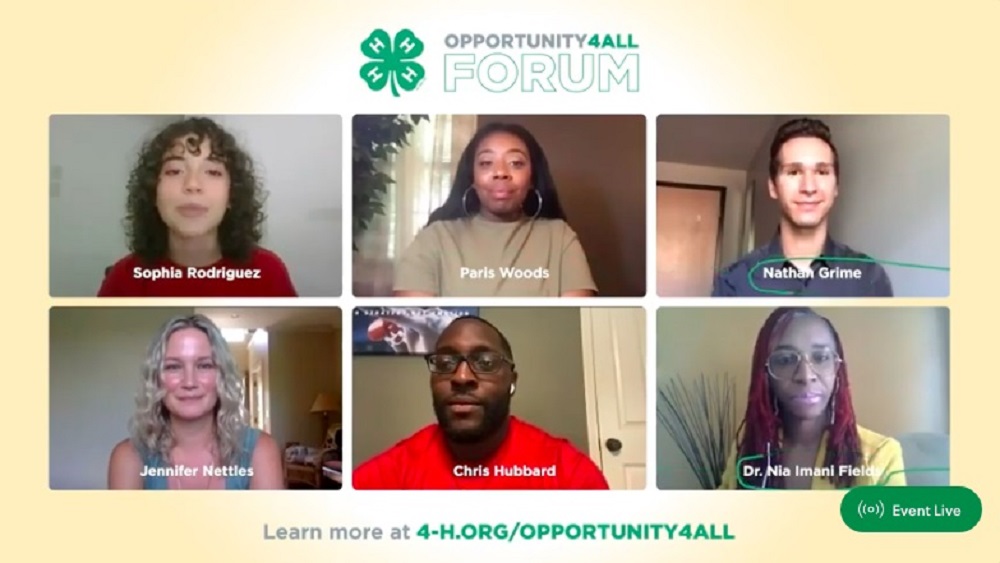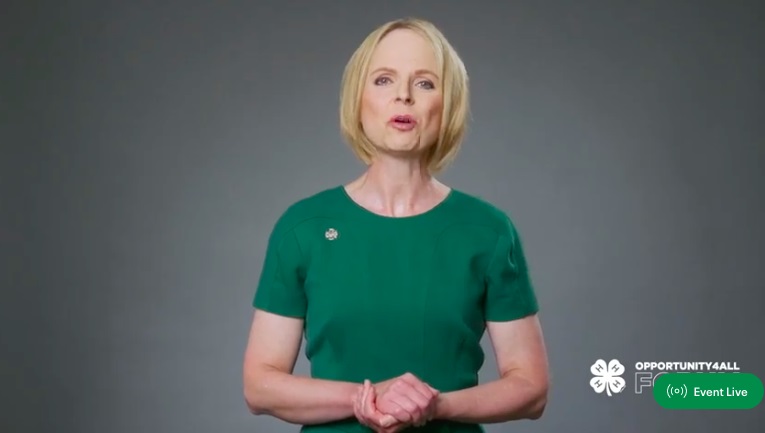
Screenshot
A virtual forum held by the National 4-H Council on Wednesday brought together 4-H youth and adult leaders along with outside panelists to discuss challenges facing youth. The event kicked off a 4-H campaign to address the opportunity gap.
4-H’s new campaign calls for a nationwide focus on positive youth development to address the opportunity gap among young people.
It plans to develop a group of 20 youth and adult teams within the Cooperative Extension System to focus on specific projects and create 90-day action plans. They will meet virtually in September and pick specific issues to work on.
“I challenge my peers,” said Tay Moore, a recent graduate of Ringgold High School in Ringgold, Louisiana, and 4-H president in the state. He issued a call to action to mobilize young people and adults to take on projects tackling inequality in an online forum Wednesday. He appeared with Jennifer Sirangelo, president and CEO of the National 4-H Council.
“It’s going to take adults partnering with young people,” Sirangelo said.
The idea is to build on the 4-H model of creating learning experiences that help young people develop their capacities, work with peers and adults, and influence their community.
A white paper released Wednesday by the National 4-H Council said the organization is responding to a historic moment in which economic inequality is growing and racial inequality is magnified.
4-H, of course, is stepping in where young people protesting racial inequality have already led — especially since George Floyd’s death sparked outrage around the nation.
But it’s in a special position to issue its call. Historically, it operated across rural America but has now advanced into cities and suburbs. Today, as one of the largest youth development organizations in the nation, it reaches 2.6 million rural youth as well as 1.6 million in suburbs and 1.8 million in cities through its clubs, camps, after-school and in-school enrichment programs. Two-thirds of participants are European American, with about 14% Hispanic and 12% African American.
“4-H is in every ZIP Code and county in America,” Siranglo said in an interview. In some areas, it may be the only existing youth development organization, she said.
Arguments about race and inclusiveness
Like so many organizations and institutions in the United States, 4-H has its own history of racial discrimination.
And racial tensions exist within the organization, according to the Des Moines Register, which last year investigated a number of complaints against Iowa 4-H. The first state-level Latino leader of Iowa 4-H, John-Paul Chaisson-Cardenas, sued last year, saying he was harassed and then fired because he advocated for greater racial equality and gender identity protection. John Lawrence, vice president of Iowa State University Extension, which runs Iowa 4H, told the newspaper that challenges around racial issues come up in the organization.
In addition, a national 4-H policy welcoming LGBT youth to 4-H — which was rescinded under pressure from the Trump administration — sparked strong opposition among conservatives and evangelical groups in the state.

Young people have a lot to deal with today, said Jennifer Sirangelo, president and CEO of the National 4-H Council.
The current moment is a critical one, the white paper said: The coronavirus pandemic has widened the gap in opportunity and threatens a whole generation.
Fifty-five million young people are negatively impacted and 12 million don’t have reliable broadband internet resources, the organization said in a statement.
Impact of the pandemic
Young people have experienced such disruption since the epidemic began, said Karen Pittman, president and CEO of the Forum for Youth Investment, who took part in the online 4-H event Wednesday as a panelist. School life, family life and community life have changed dramatically, she said.
“All of those simultaneously got flipped,” Pittman said.
It’s vital to build opportunities for young people to work with peers and community and gain a variety of competencies, she said. Then they need opportunities to apply their skills in real-life situations where there is meaning and consequence, she said.
Young people active in 4-H also spoke at the event.
“We are not going to stand by and ignore racial injustice,” said Janya Green, a 4-H member and high school student from Sylvester, Georgia.
Talon Callahan, a 4-H digital ambassador from Ferry County, Washington, said youth activism won’t go away after the coronavirus epidemic ends.
Sophia Rodriguez, a 4-H teen leader in Georgia, said youth have been emboldened, channeling stress and rage into positive ways to address issues. Adults need to dismantle their personal and professional biases, she said.
Nathan Grine, a 4-H youth leader in Ohio, said: “We’re going to have to hold each other accountable to change this [and move it] from just a conversation to action.”
Moving to action
Young people will consider what equity means to them and identify an issue in their community, Sirangelo said. Issues could range from food insecurity to LGBT engagement to the integration of immigrants in their community, she said.
‘That’s where we start — from the young person’s point of view,” she said.
At the September gathering, they will get training on how to plan their project, link to others in the community who can champion the project and make change. They will also network with 4-H groups in other counties, she said.
“That’s how it spreads in a state,” she said.
“[In addition] we will be convening a town hall of teens later this fall … to amplify their voices about what opportunity looks like and how to impact others in their community,” Sirangelo said.
Political divisiveness
4-H will be working with many partner organizations. No one youth development organization can bridge the opportunity gap in the United States, she said.
A potential obstacle for the campaign is that — particularly in the current polarized political climate — ideas about racism and inequality are flash points.
Sirangelo acknowledged that the wide reach of 4-H means that it includes people of widely different political opinions.
“Our footprint reflects the diversity of the United States,” she said. “But 4-H has a singular mission: positive youth development. We focus on our mission of investing in our youth. We don’t allow ourselves to be dragged into one side or the other.”
Youth development organizations function on the principles that youth are not problems to be solved and they are not clients of the organization’s services, Sirangelo said.
“They are co-creators of our programs,” she said. “We are going to keep our mission focused on them … that will be our compass.”





























